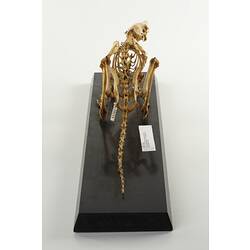Summary
Greater Bilbies are a small, usually solitary Australian marsupial related to Bandicoots. They are burrowers, digging extensive tunnel systems in which they shelter during the day. They do not drink, getting all their required water from their food, including insects, plant and fungus material and small animals.
Greater Bilbies once occurred across a large portion of Australia's arid and semi-arid mainland. Their range began to decline northwards after European settlement and today they are restricted to relatively small desert areas of the Northern Territory and Western Australia and a separated population in south-western Queensland.
This specimen was collected from the Victoria-New South Wales border along the Murray River. It was registered in 1869 and may have been collected some years prior to this.
There used to be two species of Bilby, the Greater Bilby and the Lesser Bilby. The Lesser Bilby became extinct in the 1950s so today the Greater Bilby is often referred to simply as the Bilby. Greater Bilbies are threatened by the same pressures that drove the Lesser Bilby extinct; habitat loss, competition with introduced sheep and rabbits and predation from foxes and feral cats.
Today there are under 10,000 Greater Bilbies in the wild and despite reintroduction efforts and other conservation programs populations are declining. The International Union for the Conservation of Nature (IUCN) therefore considers the Greater Bilby to be Vulnerable. They are also listed on Appendix I of the Convention for International Trade in Endangered Species (CITES) to prevent international trade from threatening them with extinction.
Specimen Details
-
Taxon Name
-
Preferred Common name
Greater Bilby
-
Number Of Specimens
1
-
Sex
Male
-
Specimen Nature
Nature: Skeleton (articulated), Form: Dry
-
Collected By
Unknown
-
Category
-
Scientific Group
-
Discipline
-
Collecting Areas
-
Type of Item
Taxonomy
-
Kingdom
-
Phylum
-
Subphylum
-
Class
-
Superorder
-
Order
-
Family
-
Genus
-
Species Name
lagotis
Geospatial Information
-
Country
-
State
-
Precise Location
Murray R banks







